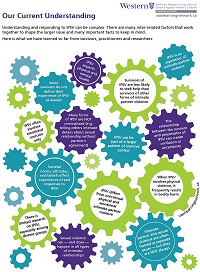Factors Impacting Understandings of Intimate Partner Sexual Violence

This inforgraphic shows our current understanding of IPSV, it acknowleges its compleities, the multiple facets it exists in and how it is understood.
View Infographic(PDF)
View Infographic(Image)
View Plain Text PDF
Our Current Understanding
Understanding and responding to IPSV can be complex. There are many inter-related factors that work together to shape the larger issue and many important facts to keep in mind. Here is what we have learned so far from survivors, practitioners and researchers:
- IPSV impacts physical and mental health
- IPSV is an expression of intimate partner violence
- Some survivors do not define their experience of IPSV as assault
- Survivors of IPSV are less likely to seek help than survivors of other forms of intimate partner violence
- IPSV often emotional coercion only
- Many forms of IPSV are NOT criminalized (e.g. telling others intimate details about sexual relationship without partner’s agreement)
- IPSV can be part of a larger coercive control
- The relationship between the survivor and perpetrator of IPSV can create confusion or uncertainty
- Societal norms, attitudes, and belief affect experience of and responses to IPSV
- IPSV differs from non-sexual physical and emotional intimate partner violence
- When IPSV involves physical violence, frequently results in bodily harm
- There is limited research on IPSV, especially among diverse groups
- Sexual violence can – and does – happen in all types of intimate relationships
- Intimate partner and sexual violence are often framed as separate issues – but they are not always
This infographic emerged from Issue-Based Newsletter 17: Intimate Partner Sexual Violence.
This collection of Learning Network resources is designed to synthesize and disseminate knowledge on topics related to Gender-Based Violence (GBV). These resources provide foundational GBV knowledge including commonly used language, important gaps and emerging issues, recent research, and important educational tools and resources.
All original materials produced by the Learning Network are open-access and can be re-used and re-distributed as long as there is proper recognition of the author and/or Learning Network.





